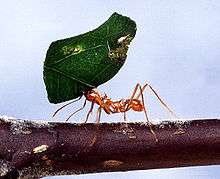Atta cephalotes
| Atta cephalotes | |
|---|---|
 | |
| Atta cephalotes worker carrying leaf segment | |
| Scientific classification | |
| Kingdom: | Animalia |
| Phylum: | Arthropoda |
| Class: | Insecta |
| Order: | Hymenoptera |
| Family: | Formicidae |
| Genus: | Atta |
| Species: | A. cephalotes |
| Binomial name | |
| Atta cephalotes (Linnaeus, 1758)[1] | |
| Synonyms | |
|
Atta cephalotes integrior Forel, 1904 | |
Atta cephalotes is a species of leafcutter ant in the tribe Attini (the fungus-growing ants). A single colony of ants can contain up to 5 million members, and each colony has one queen that can live more than 15 years. The colony comprises different castes, known as 'task partitioning', and each caste has a different job to do.
Taxonomy
The species is one of the earliest formally classified ants, first described by Swedish zoologist Carl Linnaeus in 1758 as Formica cephalotes in the 10th edition of Systema Naturae together with sixteen other ant species, all of which he placed in the genus Formica.[2] It was later transferred to a new genus, Atta, along with five other species by Danish zoologist Johan Christian Fabricius in 1804.[3] In 1911, American entomologist William Morton Wheeler designated A. cephalotes as the type species of Atta.[4] It was also designated as the type species of Oecodoma, but the genus is now a synonym of Atta.[5]
The specific name cephalotes is derived from Greek cephalē, "head", in reference to their relatively large heads.[6]
Biology and behaviour
A special caste of workers manage the colony's rubbish dump. These ants are excluded from the rest of the colony. If any wander outside the dump, the other ants will kill or force them back. Rubbish workers are often contaminated with disease and toxins, and live only half as long as their peers.[7]
Distribution and habitat
The species is widely distributed in the Neotropical region, from Mexico to Bolivia, with disjunct populations in Amazonas and north-eastern Brazil.[8]
Across the rainforest floor they occupy an area typically an area of approximately 20 feet. They live in nests that can be as deep as 7 metres that they have carefully positioned so that a breeze can rid the nest of the dangerous levels of CO2 given off by the fungus they farm and eat.
References
- ↑ "Species: Atta cephalotes". AntWeb. 2010-06-30. Retrieved 2010-08-20.
- ↑ Linnaeus, C. (1758). Systema naturae per regna tria naturae, secundum classes, ordines, genera, species, cum characteribus, differentiis, synonymis, locis. Tomus I (10th ed.). Holmiae. (Laurentii Salvii). pp. 579–582.
- ↑ Fabricius, J. C. 1804. Systema Piezatorum secundum ordines, genera, species, adjectis synonymis, locis, observationibus, descriptionibus. Brunswick: C. Reichard, p. 421
- ↑ Wheeler, W. M. (1911). "A list of the type species of the genera and subgenera of Formicidae". Annals of the New York Academy of Sciences. 21: 157–175. doi:10.1111/j.1749-6632.1911.tb56932.x.
- ↑ Swainson, W.; Shuckard, W.E. (1840). On the history and natural arrangement of insects. 104. London, UK: Longman, Brown, Green & Longman's. p. 174. doi:10.5962/bhl.title.32786. OCLC 4329243.
- ↑ Hoyt, Erich (1997). The Earth Dwellers: Adventures in the Land of Ants. Simon and Schuster. p. 26. ISBN 978-0-684-83045-2.
- ↑ "Treated like garbage". New Scientist. 2001-01-20. Retrieved 2015-08-17.
- ↑ Corrêa, M.M.; Bieber, A.G.D.; Wirth, R.; Leal, I.R. (2005). "Occurrence of Atta cephalotes (L.) (Hymenoptera: Formicidae) in Alagoas, Northeastern Brazil". Neotropical Entomology. 34 (4): 695–698. doi:10.1590/S1519-566X2005000400023.
External links
 Media related to Atta cephalotes at Wikimedia Commons
Media related to Atta cephalotes at Wikimedia Commons